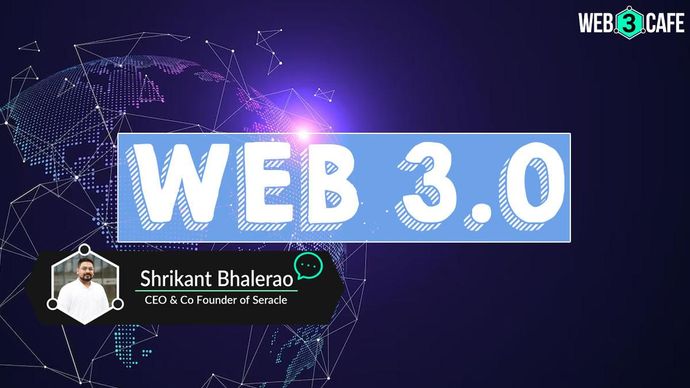India's Web3 Evolution: Opportunities and challenges & global infrastructure's role in India's Web3 space |OPINION
An opinion piece by Seracle's Shrikant Bhalerao on India's Web3 Evolution and the opportunities as well as challenges which the country may face in its path towards becoming a Web3 superpower.

As the founder of Seracle, a Web3 Infrastructure as a Service platform, I have been closely following India's Web3 evolution. In this article, I will discuss the opportunities and challenges that India faces as it moves towards a decentralised and Web3-based future.
According to a report by Nasscom, India has a large and rapidly growing population of developers, with an estimated 4.2 million developers in the country as of 2022. India's Web3 evolution has been shaped by a variety of factors, including the rise of blockchain technology, the growth of the Indian startup ecosystem, and the country's unique socio-economic landscape. A Nasscom report also states the Indian blockchain industry is expected to grow at a CAGR of 66.2% between 2021 and 2025.
The adoption of blockchain technology in India has been on the rise, with the Indian government recognising its potential to transform key sectors such as finance, healthcare, and supply chain management. This has been further fueled by the growth of the Indian startup ecosystem, which has seen a surge of Web3 startups such as Polygon gaining international recognition and driving innovation in areas such as DeFi, NFTs, and DAOs.
How did it begin?
In the early days of blockchain, the technology was still largely unknown to most people in India. However, a few forward-thinking individuals and startups saw the potential of this new technology and began experimenting with it.
One such early adopter was an Indian startup called Koinex, which launched in August 2017 as a cryptocurrency exchange. Koinex quickly gained popularity, attracting thousands of users in a matter of months.
Around the same time, the Indian government was starting to take notice of blockchain technology, recognizing its potential to transform key sectors such as finance, healthcare, and supply chain management. The government launched several initiatives to promote blockchain adoption, including the creation of a blockchain-based e-governance platform and the implementation of blockchain-based voting systems.
As more people in India became aware of blockchain technology, interest in Web3 and decentralized applications began to grow. This interest was further fueled by the emergence of a vibrant Web3 ecosystem in India, with startups such as Polygon gaining international recognition and driving innovation in areas such as DeFi, NFTs, and DAOs. Polygon (formerly Matic), has seen its native token increase in value by over 22,000% since its launch in 2019.
Today, India's Web3 space is thriving, with a growing number of startups, developers, and enthusiasts working to build a more decentralised and Web3-based future. While there are certainly challenges to be faced, including regulatory uncertainty and limited access to funding and support, the potential for Web3 in India is immense, and the country is poised to become a major player in the global Web3 ecosystem.
The Opportunities:
- The potential for blockchain technology to transform key sectors such as finance, healthcare, and supply chain management in India, as evidenced by successful use cases such as the Indian government's e-governance platform, blockchain-based voting systems, and financial inclusion initiatives.
- The emergence of a vibrant Web3 ecosystem in India.
- The country's large pool of talented developers who have the potential to become leaders in Web3 development and contribute to the global Web3 ecosystem.
- India’s unique socio-economic landscape, characterized by a large population, rapid urbanisation, and a growing middle class, also presents both opportunities and challenges for the Web3 space in India.
Challenges:
- The lack of regulatory clarity and uncertainty surrounding blockchain and cryptocurrency in India, which has led to a number of high-profile cases of regulatory crackdowns and legal battles.
- The limited access to funding and support for Web3 startups in India can make it difficult for them to compete with established players in the global market.
- The digital divide and lack of internet penetration in certain parts of the country, can hinder the adoption of Web3 technologies and limit their impact on society.
Web3 infrastructure provider’s role in India's Web3 evolution
The mission of IaaS platforms like yours is to empower Web3 startups and developers in India by providing them with the tools and resources they need to build innovative solutions and scale their businesses. It is our collective commitment to promoting regulatory clarity and fostering a supportive ecosystem for Web3 in India through initiatives such as our partnership with India's Ministry of Electronics and Information Technology and our participation in industry forums and associations.
To overcome the current challenges and drive innovation and growth in the Indian Web3 space, it is essential that all stakeholders come together and work collaboratively. This means that companies like Seracle must continue to innovate and provide high-quality infrastructure and services to support the development of Web3 applications and platforms. It also means that policymakers and regulators must work closely with industry players to create a supportive and enabling regulatory environment that encourages innovation while protecting consumers and investors.
Finally, it means that developers, entrepreneurs, and investors must continue to collaborate and share knowledge, resources, and expertise to drive innovation and growth in the Indian Web3 space. This could involve everything from participating in hackathons and networking events to investing in Web3 startups and sharing technical knowledge and best practices.
